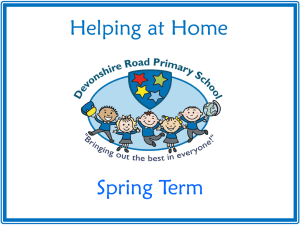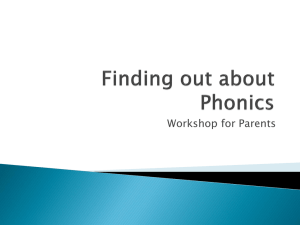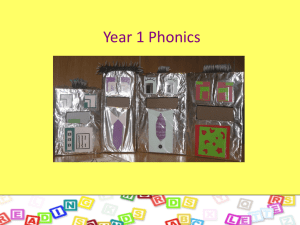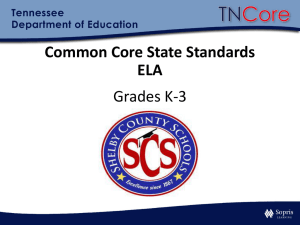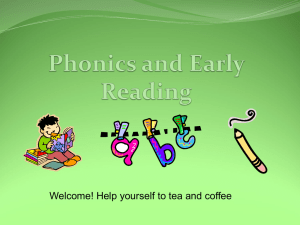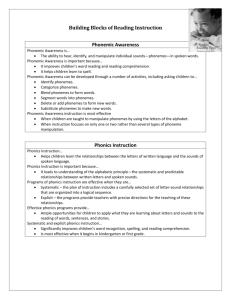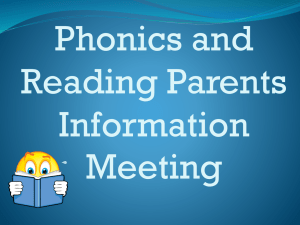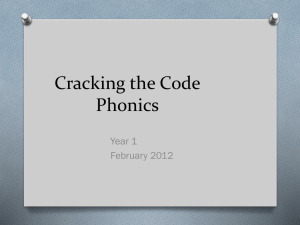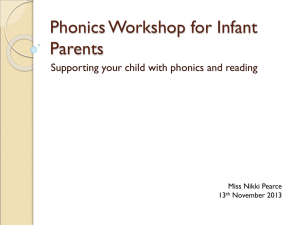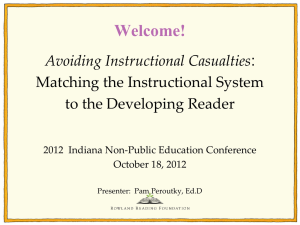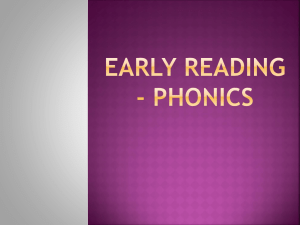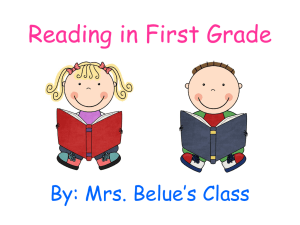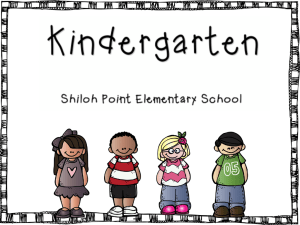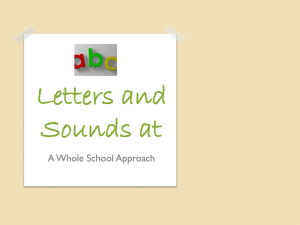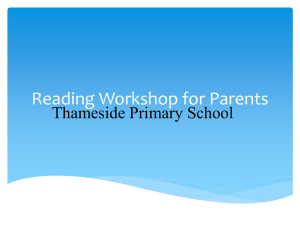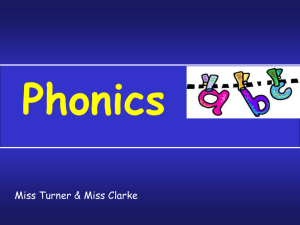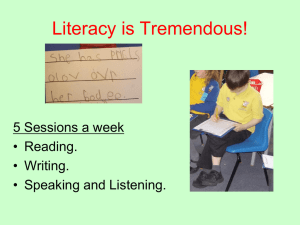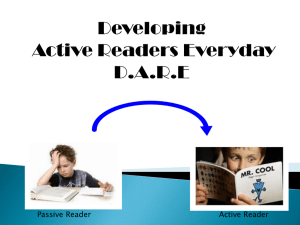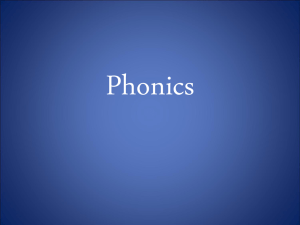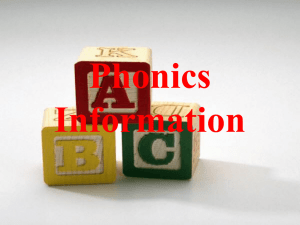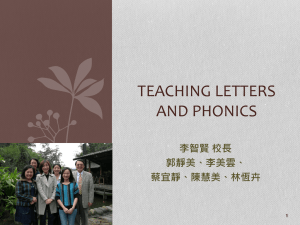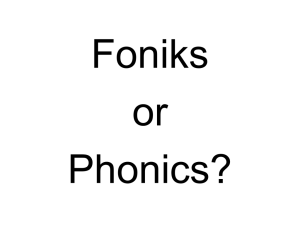File - Hodnet Primary School
advertisement
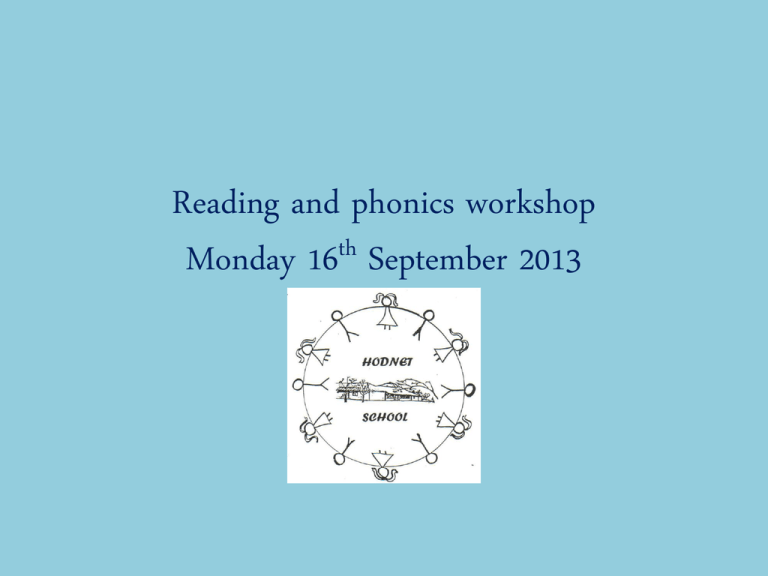
Reading and phonics workshop th Monday 16 September 2013 Aims of the workshop • To enable parents to support children’s reading and phonetics development at home • To inform you on how we teach reading and phonics at school reading • To answer any questions you may have about phonics and reading Reading skills Language comprehension processes Poor word recognition, good language comprehension. Word recognition process Good word recognition, good language comprehension. Word recognition process Poor word recognition, poor language comprehension. Language comprehension process Good word recognition, poor language comprehension. A reading environment Reading different texts Phonics – what are we talking about? • Starting in pre school children will follow the letters and sounds programme • Children will have a dedicated phonics session each day • This is split into phases – phase one helps children to listen to sounds in preparation for learning sounds, this phase is usually covered in a pre school setting. • Phase 2 – introducing 19 phonemes and how to blend these in order to read. Phase one Pre school learning – This paves the way for systematic phonics learning. -It involves teaching children to listen attentively, develop vocabulary, speak confidently to adults and children, discriminate phonemes, reproduce phonemes they hear and use sound talk. Seven aspects of phase one • • • • • • • 1 – general sound discrimination – environmental sounds. 2 - general sound discrimination – instrumental sounds. 3 - general sound discrimination – body percussion. 4 – Rhythm and rhyme. 5 – Alliteration. 6 – Voice sounds. 7 – Oral blending and segmenting. Phase 2 Phonics Phase 2 • We will continue to practise and develop what is learnt in phase 1. • Learning new phonemes and their graphemes. What is a phoneme and a grapheme? • A phoneme is the smallest unit of sound in speech (show DVD) • There are 40 phonemes in the English language • A grapheme is a letter or number of letters that represents that sound eg, a, ay, igh What is blending? • This is used when reading, it is referred to in class as sound blending and children are taught to do this in order to read new words. In class R it is essential that we use our “magic reading fingers” to point to the sounds. • Children use phoneme recognition to put sounds together to make the words. mat . . . Blending to read Phase 3 • To teach more graphemes – Ch, sh, th, ng, ai, ee, igh, oa, oo, are, or, ur, ow, oi, ear, air, ure, er More phonics • Phase 4 – blending (in order to build phonemes together to read words) and segmenting (breaking down words in order to spell them) • Phase 5 – this takes place in year one – learning new graphemes and alternative pronunciations and spellings. • Phase 6 – year two and beyond – applying spelling skills and rules. Phase 4 • Reading a wider range of CVCC and CCVCC words. • Getting his magic reading finger reading for sound blending! Phase 5 Re-reading the sentence • Once your child has decoded each word or the words that they need to in order to read the sentence ensure that they re-read the sentence for understanding. Put the cat in the mug. What other strategies can be used? • Using the pictures as a clue along with the initial phoneme – this is not cheating. • Recognising high frequency words. What are high frequency words? • These are the common words that the reader will come across very early in their reading experience as they appear in even the simplest of texts. • Some of these are de-codable such as and, Dad etc. Some of them are called “tricky words” such as was, you, the. • If a child can read the first 100 high frequency words they have access to 50% of virtually any text. High frequency words • Children should be able to read these on sight eventually with out having to sound blend them. • When there is a combination of sight recognition of high frequency words and a knowledge of phonics then a child's reading can really take off. Tricky words • Phase 2 – the, to, go, no • Phase 3 – he, she, we, be, was, my, you, her, they, all, are. • Phase 4 – some, one, said, come, do, so, were, when, have, there, out, like, little, what. Reading books • We primarily use the Oxford Reading Tree scheme of reading books, children start off with the grey level and then progress to the lilac level. • As they become more confident with phonics and recalling high frequency words they will progress through other levels. Group reading • Children share a book as a group. • They take it in turns to read. • We look at the conventions of the book – front cover, blurb etc. • The day after the children discuss the book they have read to develop comprehension skills. Comprehension • Without understanding the text reading is meaningless. • Talking about the book you have read is as important as decoding the book you have read. • Develop understanding of the text by asking questions - What do you think? But there’s more… • There is a difference between someone who can read and a reader. • Decoding is important but understanding what they have read is just as important. • Talking about the book is great…this helps understanding and comprehension of what they have read. Reading a book more than once • It is important that, especially in the early stages of reading, that children read a book more than once. • Even returning to a book that they have read weeks, months or even years ago has value…especially with higher level reading skills such as comprehension, identifying with characters or situations. Asking questions • This is an important part of a reading session – it enables you to see if they have understood what they have read. • As your child becomes a more confident reader they will be able to return to the text and use this to answer questions. They may be able to find words or phrases that support answers. Assessing reading • In school we asses your child's progress in reading by listening to them read individually and in groups and providing feedback. • Using formal phonics assessments and tracking. • APP – in year one and year two. • Formal assessments – year one phonics screening, year two SATs. Year one phonics screening • This was established 2 years ago to give teachers and parents information about how the child is progressing in phonics. • There are 2 sections with 40 words in and they will assess children’s phonics skills learnt in year one and reception. At school… • We aim to read individually with children as much as is possible, through teacher reading, TA reading and parent volunteer reading. • Children take part in group reading sessions at least once a week. • Children have daily letters and sounds lessons – where reading is given high priority • We encourage reading to be fun! At school… • We aim to read a range of fiction and non fiction stories. • We have reading dens and reading areas • We encourage children to use bug club an online book store where they can read varied and enjoyable texts and answer questions about them. The perfect reading environment • • • • Quiet, calm and focused Make children aware that this is their reading time. Enjoy laughing at the funny parts of a story together Talk about what is happening in the pictures. Allow your child to read to the end of the sentence with out interrupting. What can you do at home? • • • • • • Role model – read books, newspapers, anything! Share exciting stories. Read a bed time story. Set the scene for reading. Reading information books. It is also a means of communicating any concerns or questions you may have. • Remember reading is FUN!!!! What can you do at home? - Try to find 5 or 10 minutes each day to share your child’s reading book and record in their reading diary. - Practise any words they may have. - Practise recognition of phonemes and recall of graphemes. - Encourage your child to par take in some of the activities provided in the pack. Any questions?
